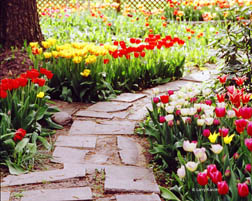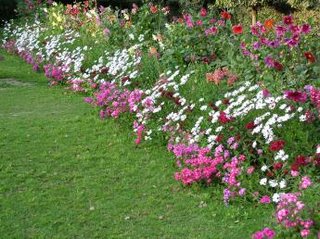Planting a Tulip Field or Tulip Garden: Next Spring Can be Heaven on Earth

If you enjoy tulips and building a tulip garden that will make your spring morning fresh and delightful, consider these tips for successful tulip planting. One of the most important aspects of building a tulip garden involves using the correct soil, and cultivating the ground for proper growth.
In order to find out what the latest tulip planting trends are you may want to attend various tulip festivals which usually happen in spring of the year. One of the most popular of those festivals is the Tulip Time Festival in Holland, Michigan. You can also view miles and miles of tulips when you visit the state of Washington and tour the Skagit Valley Tulip Festival. Photos of tulips from these festivals are available online, and you can sign up to hear more about these particular events. You will also want to consult tulip planting experts for further help on how to create your money making tulip operation.
These helpful tulip garden design tips can help you create flower beds as attractive one of your favorite well-known flower gardens. You have quite a few different types of tulips to choose from to plant in your garden. If you design your tulip garden carefully enough you can use it as a promotional tool to attract buyers of tulips and act as if you have your own tulip festival in your backyard.
Tulips are much different from perennials in terms of planting. Tulips prefer a sandy-based soil that is well-drained. Tulip bulbs will not grow well in solid saturated with water that is extremely wet. Additional tips for planting tulips to build a healthy garden are included in this article.
In order to establish proper drainage in your tulip garden, plant tulip bulbs on slightly raised ground. This will shunt excess water away from the bulbs and prevent rotting. You may also consider designing a system that drains excess water from the tulip bed. If you wish to build a flat-bedded tulip garden, make sure to add a peat moss along or compost mixture to the soil, and mix together with the ground soil thoroughly. If the soil in your garden is not sandy enough for tulip bulbs, consider adding some sand and mixing it well with the soil.
Check with your local garden supply dealer for exact details about the proper proportion of sand to the soil in your area.
When planting tulips bulbs, make sure to plant the pointed end up. The best time to plant is when the ground is 60 degrees or colder. The prime planting time for tulips is after November first, so that the bulbs will incubate properly and develop a solid root structure, which is what they need. Then, in early to late spring, depending upon which species of tulips you plant, tulips will sprout and blossom in order to grow to their maximum length.
Another way to make sure your tulips remain cool during the winter months is to plant them in a lightly shaded area, but making sure you plant them in areas that will provide the tulips with enough light for growth. Make sure that you insert the bulbs far enough into the ground. Usually they are planted approximately 6 inches below ground although jumbo tulips can be buried as deep as 9 inches.
If you live in a warmer climate you will have to chill them in a cooler below 60 degrees for the same length of time that you would if you were going to plant them right away. If it has not rained in your area before you plant your flower beds you will want to make sure that water them until the soil is moist.
You can use similar techniques to attract customers to your tulip shop as you would if you had any other business. One of the most useful tools of attracting customers is to have a professional-looking appearance with samples of your items for sale displayed. This is true no matter what kind of business you run, and is true for creating an atmosphere which will encourage customers to purchase fresh tulips from you. It takes planting the right garden design and choosing the right tulips to make this happen.
One of the most popular types of tulips is the numerous varieties of single tulips. Examples of different-colored single tulips include the bold red Kingsblood tulip, which appears to represent both royalty and victory. You can also find other varieties of red tulips to plant in your garden of which the brightness of the red helps define any garden. These are called the Red Parade or the Hollandia tulip. Another popular color for tulip planting would be the white tulip, which would be ideal for a wedding ceremony. One example of a single-blooming white tulip is called the Maureen Tulip. You can also find single tulip flowers which are purple, magenta, orange, and royal purple. These types of tulips are known to be very pleasing to most customers' eyes, and are sold in many professional flower shops.
You can also build an attractive garden using double-blooming varieties of tulips such as the Peach Melba, Cool Crystal, or Royal Acres tulip. Along with that, you can plant those that have fringed edges on the petals, or ones that have long curly petals (parrot style tulips). When you plant your garden you can craft it any way you like, but if you want to sell your tulips, you will want to arrange your garden design in a way that will make customers want to buy from you.
Some useful garden planting tips are to make sure that you plant flowers that will bloom at same or similar times. Not only that, but you will want to place them in organized formations. One of the most popular tulip garden design patterns is to plant square or rectangle patches that contain several rows of evenly-rowed tulips of the same color. Other tulip gardens are designed in a way in which small clusters of tulips of different colors and types will grow and bloom together. In order for these gardens to grow properly you will want to make sure to plant them only a few inches apart.
Article Source: http://www.article-exposure.com
Dave Pipitone is a professional communicator who plants tulips in his Hope Patch every year. He is a dedicated husband and father, as well as a spiritual entrepreneur. For more information about tulip colors and styles, please visit www.tulipreview.com.








